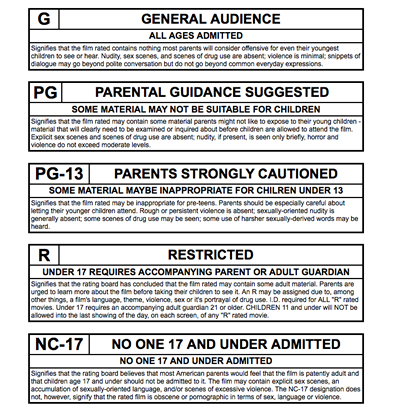Current Rating Systems
 The current rating system has been in place since the late 1960s.
The current rating system has been in place since the late 1960s.
As with previous systems, there is no requirement that all films be rated, but it is very difficult to get unrated films distributed.
Further, film makers have extremely strong incentives to achieve certain ratings. A children's film may fail if it is rated PG-13 rather than PG. And, there has never been a commercially successful wide release NC-17 film.
When you see "this film not yet rated" people are usually arguing about what needs to be censored.
Relatively mild regimes of censorship have both good and bad effects. They interfere with artistic freedom and public rights. But, if you can't show or say things directly, you need to come up with creative ways to get your message across. And this led to some good films.
Next: sound
 As with so much else, streaming services and large TVs have fundamentally undermined the ratings system. First, the traditional movie ratings were, at least in theory, administered by the independent Motion Pictures Association. TV shows do have ratings, but what rating they get is decided by the networks and services that distribute them rather than an independent board. Second, TVs are equipped with V chips that allow parents to set what kids are allowed to see... but how often these are used and what percentage of 10 year olds know how to get around them easily is anyone's guess. One survey I found says that about 1/3 of parents use V chips. Honestly, ratings are a good thing. People should be informed ahead of time about the amount of sex and violence in what they're about to watch. However, in an era when anyone with a cell phone can access internet porn or images from battlefields and executions, censorship has a different meaning. Censorship still determines what you see in movie theatres and on the major cable channels. It's much harder for the government or anyone else to stop people from accessing whatever they want on the web.
As with so much else, streaming services and large TVs have fundamentally undermined the ratings system. First, the traditional movie ratings were, at least in theory, administered by the independent Motion Pictures Association. TV shows do have ratings, but what rating they get is decided by the networks and services that distribute them rather than an independent board. Second, TVs are equipped with V chips that allow parents to set what kids are allowed to see... but how often these are used and what percentage of 10 year olds know how to get around them easily is anyone's guess. One survey I found says that about 1/3 of parents use V chips. Honestly, ratings are a good thing. People should be informed ahead of time about the amount of sex and violence in what they're about to watch. However, in an era when anyone with a cell phone can access internet porn or images from battlefields and executions, censorship has a different meaning. Censorship still determines what you see in movie theatres and on the major cable channels. It's much harder for the government or anyone else to stop people from accessing whatever they want on the web.
 The current rating system has been in place since the late 1960s.
The current rating system has been in place since the late 1960s.  As with so much else, streaming services and large TVs have fundamentally undermined the ratings system. First, the traditional movie ratings were, at least in theory, administered by the independent Motion Pictures Association. TV shows do have ratings, but what rating they get is decided by the networks and services that distribute them rather than an independent board. Second, TVs are equipped with V chips that allow parents to set what kids are allowed to see... but how often these are used and what percentage of 10 year olds know how to get around them easily is anyone's guess. One survey I found says that about 1/3 of parents use V chips. Honestly, ratings are a good thing. People should be informed ahead of time about the amount of sex and violence in what they're about to watch. However, in an era when anyone with a cell phone can access internet porn or images from battlefields and executions, censorship has a different meaning. Censorship still determines what you see in movie theatres and on the major cable channels. It's much harder for the government or anyone else to stop people from accessing whatever they want on the web.
As with so much else, streaming services and large TVs have fundamentally undermined the ratings system. First, the traditional movie ratings were, at least in theory, administered by the independent Motion Pictures Association. TV shows do have ratings, but what rating they get is decided by the networks and services that distribute them rather than an independent board. Second, TVs are equipped with V chips that allow parents to set what kids are allowed to see... but how often these are used and what percentage of 10 year olds know how to get around them easily is anyone's guess. One survey I found says that about 1/3 of parents use V chips. Honestly, ratings are a good thing. People should be informed ahead of time about the amount of sex and violence in what they're about to watch. However, in an era when anyone with a cell phone can access internet porn or images from battlefields and executions, censorship has a different meaning. Censorship still determines what you see in movie theatres and on the major cable channels. It's much harder for the government or anyone else to stop people from accessing whatever they want on the web.